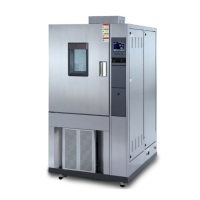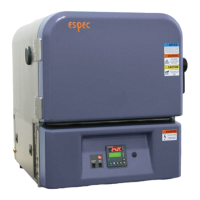Do you have a question about the ESPEC Platinous ESX-4C Series and is the answer not in the manual?
Explains the meaning of various safety symbols used in the manual.
Guides users on interpreting the model number for chamber configuration.
Details the standard description and configuration of Platinous chambers.
Lists included accessories and spare parts for the chamber.
Lists explosive, flammable, and corrosive substances that must not be placed inside.
Explains the importance of setting safety devices for specimen protection.
Provides an example of setting overheat protector and high limit alarms.
Provides instructions for safely disposing of the chamber.
Covers important precautions like grounding, air blasts, and temperature extremes.
Emphasizes compliance with all warning and caution labels on the chamber.
Lists global warming potentials for refrigerants used in ESPEC chambers.
Describes the purpose and testing capabilities of Platinous Series chambers.
Explains the BTHC system for balanced temperature and humidity control.
Details the operation of the BTHC system.
Describes the SCP-220 instrumentation for constant and program modes.
Identifies and explains the function of front and right side parts.
Identifies and explains the function of left, rear, and top side parts.
Details components within the test area, like shelves and gaskets.
Details ceiling components like airflow registers and sensors.
Describes the instrumentation panel, including operating and hour meters.
Explains the functions of the touchscreen operating panel and its buttons.
Identifies components within the electrical compartment.
Identifies components within the water circuit compartment.
Specifies conditions and space requirements for proper chamber installation.
Provides instructions for leveling, anchoring, and moving the chamber.
Details voltage, current, and breaker requirements for power supply.
Instructions for connecting the power cable and grounding the equipment.
Procedure for removing the compressor shipping bracket before operation.
Guidelines for connecting water supply and drainage for water-cooled models.
Instructions for connecting the drain hose for water removal.
Steps for checking and ensuring correct water levels in the humidity system.
Details on removing protective sponges from water level regulators.
Procedure to verify adequate water level in the humidifying tray.
Instructions for regulating water level in the humidifying tray regulator.
Procedure for checking and adjusting water level in the wick pan.
Guidelines for arranging specimens to ensure proper air circulation.
Proper placement of specimens for optimal temperature and humidity uniformity.
Instructions for safely connecting power to specimens.
Procedure for checking and installing the wet-bulb wick for humidity tests.
How to set overheat protector and high/low limit alarms.
Procedure for setting the overheat protector before tests.
Configuring absolute high/low and deviation limit alarms for safety.
How to input desired temperature and humidity for constant mode operation.
Steps for starting and ending a test cycle on the chamber.
Methods to prevent dew formation during temperature-only operations.
Overview of additional features like refrigeration control and time signals.
Explains how to set and use refrigeration capacity control modes.
How to use time signals to control external equipment or specimens.
Description of the external alarm terminal for safety device tripping notifications.
Lists periodic checks and maintenance tasks for the chamber.
Details procedures for checking main power switch and overheat protector.
Procedure for testing the main power switch trip function.
Procedure for testing the overheat protector functionality.
Procedures for various maintenance tasks like cleaning components.
Instructions for cleaning the condenser to remove dust.
Steps for cleaning the water filter strainer.
Instructions for cleaning the humidifying tray and heater.
Procedure for maintaining the humidifier atomizing nozzles.
How to clean the test area to ensure accurate results.
Procedure for cleaning dust buildup in electrical and water compartments.
Steps for taking down the chamber before extended periods of non-use.
Lists consumable parts and their recommended replacement intervals.
Guide to identifying and resolving issues indicated by alarm codes.
Procedures for silencing and clearing alarms based on operating mode.
A comprehensive table of alarm codes, causes, and remedial actions.
Addresses common operator errors and other non-alarm related issues.
Instructions for user-serviceable components like fuses and lamps.
Step-by-step guide for replacing fuses in the electric compartment.
Procedure for replacing a burnt-out or old chamber lamp bulb.
Instructions for replacing a faulty chamber lamp starter.
Procedure for defrosting the cooler and test area when frost forms.
Provides an overview of key specifications across different chamber series.
Detailed specifications for ESL series chambers.
Detailed specifications for ESU series chambers.
Detailed specifications for ESX series chambers.
Detailed specifications for ESZ series chambers.
Defines key terms and concepts used in the manual.
Steps for requesting warranty service and parts.
Explains the meaning of various safety symbols used in the manual.
Guides users on interpreting the model number for chamber configuration.
Details the standard description and configuration of Platinous chambers.
Lists included accessories and spare parts for the chamber.
Lists explosive, flammable, and corrosive substances that must not be placed inside.
Explains the importance of setting safety devices for specimen protection.
Provides an example of setting overheat protector and high limit alarms.
Provides instructions for safely disposing of the chamber.
Covers important precautions like grounding, air blasts, and temperature extremes.
Emphasizes compliance with all warning and caution labels on the chamber.
Lists global warming potentials for refrigerants used in ESPEC chambers.
Describes the purpose and testing capabilities of Platinous Series chambers.
Explains the BTHC system for balanced temperature and humidity control.
Details the operation of the BTHC system.
Describes the SCP-220 instrumentation for constant and program modes.
Identifies and explains the function of front and right side parts.
Identifies and explains the function of left, rear, and top side parts.
Details components within the test area, like shelves and gaskets.
Details ceiling components like airflow registers and sensors.
Describes the instrumentation panel, including operating and hour meters.
Explains the functions of the touchscreen operating panel and its buttons.
Identifies components within the electrical compartment.
Identifies components within the water circuit compartment.
Specifies conditions and space requirements for proper chamber installation.
Provides instructions for leveling, anchoring, and moving the chamber.
Details voltage, current, and breaker requirements for power supply.
Instructions for connecting the power cable and grounding the equipment.
Procedure for removing the compressor shipping bracket before operation.
Guidelines for connecting water supply and drainage for water-cooled models.
Instructions for connecting the drain hose for water removal.
Steps for checking and ensuring correct water levels in the humidity system.
Details on removing protective sponges from water level regulators.
Procedure to verify adequate water level in the humidifying tray.
Instructions for regulating water level in the humidifying tray regulator.
Procedure for checking and adjusting water level in the wick pan.
Guidelines for arranging specimens to ensure proper air circulation.
Proper placement of specimens for optimal temperature and humidity uniformity.
Instructions for safely connecting power to specimens.
Procedure for checking and installing the wet-bulb wick for humidity tests.
How to set overheat protector and high/low limit alarms.
Procedure for setting the overheat protector before tests.
Configuring absolute high/low and deviation limit alarms for safety.
How to input desired temperature and humidity for constant mode operation.
Steps for starting and ending a test cycle on the chamber.
Methods to prevent dew formation during temperature-only operations.
Overview of additional features like refrigeration control and time signals.
Explains how to set and use refrigeration capacity control modes.
How to use time signals to control external equipment or specimens.
Description of the external alarm terminal for safety device tripping notifications.
Lists periodic checks and maintenance tasks for the chamber.
Details procedures for checking main power switch and overheat protector.
Procedure for testing the main power switch trip function.
Procedure for testing the overheat protector functionality.
Procedures for various maintenance tasks like cleaning components.
Instructions for cleaning the condenser to remove dust.
Steps for cleaning the water filter strainer.
Instructions for cleaning the humidifying tray and heater.
Procedure for maintaining the humidifier atomizing nozzles.
How to clean the test area to ensure accurate results.
Procedure for cleaning dust buildup in electrical and water compartments.
Steps for taking down the chamber before extended periods of non-use.
Lists consumable parts and their recommended replacement intervals.
Guide to identifying and resolving issues indicated by alarm codes.
Procedures for silencing and clearing alarms based on operating mode.
A comprehensive table of alarm codes, causes, and remedial actions.
Addresses common operator errors and other non-alarm related issues.
Instructions for user-serviceable components like fuses and lamps.
Step-by-step guide for replacing fuses in the electric compartment.
Procedure for replacing a burnt-out or old chamber lamp bulb.
Instructions for replacing a faulty chamber lamp starter.
Procedure for defrosting the cooler and test area when frost forms.
Provides an overview of key specifications across different chamber series.
Detailed specifications for ESL series chambers.
Detailed specifications for ESU series chambers.
Detailed specifications for ESX series chambers.
Detailed specifications for ESZ series chambers.
Defines key terms and concepts used in the manual.
Steps for requesting warranty service and parts.
| Brand | ESPEC |
|---|---|
| Model | Platinous ESX-4C Series |
| Category | Climate chamber |
| Language | English |

